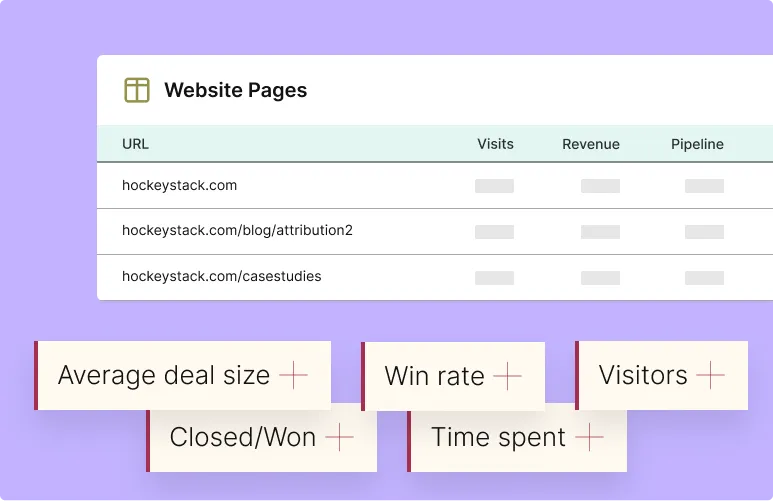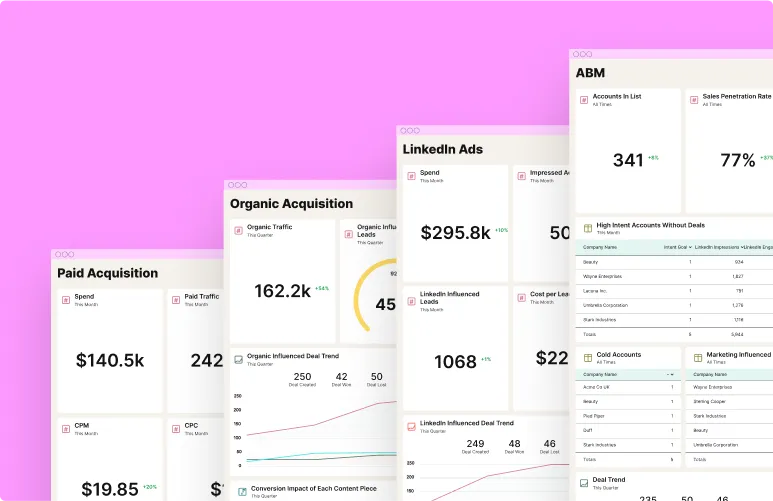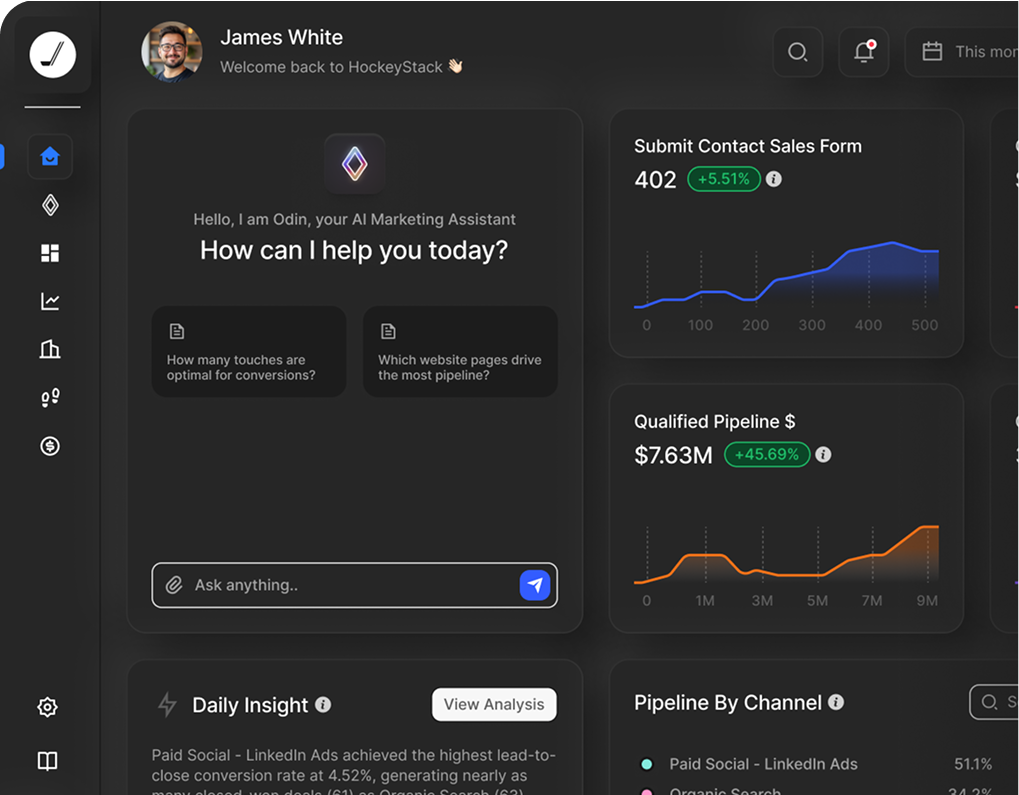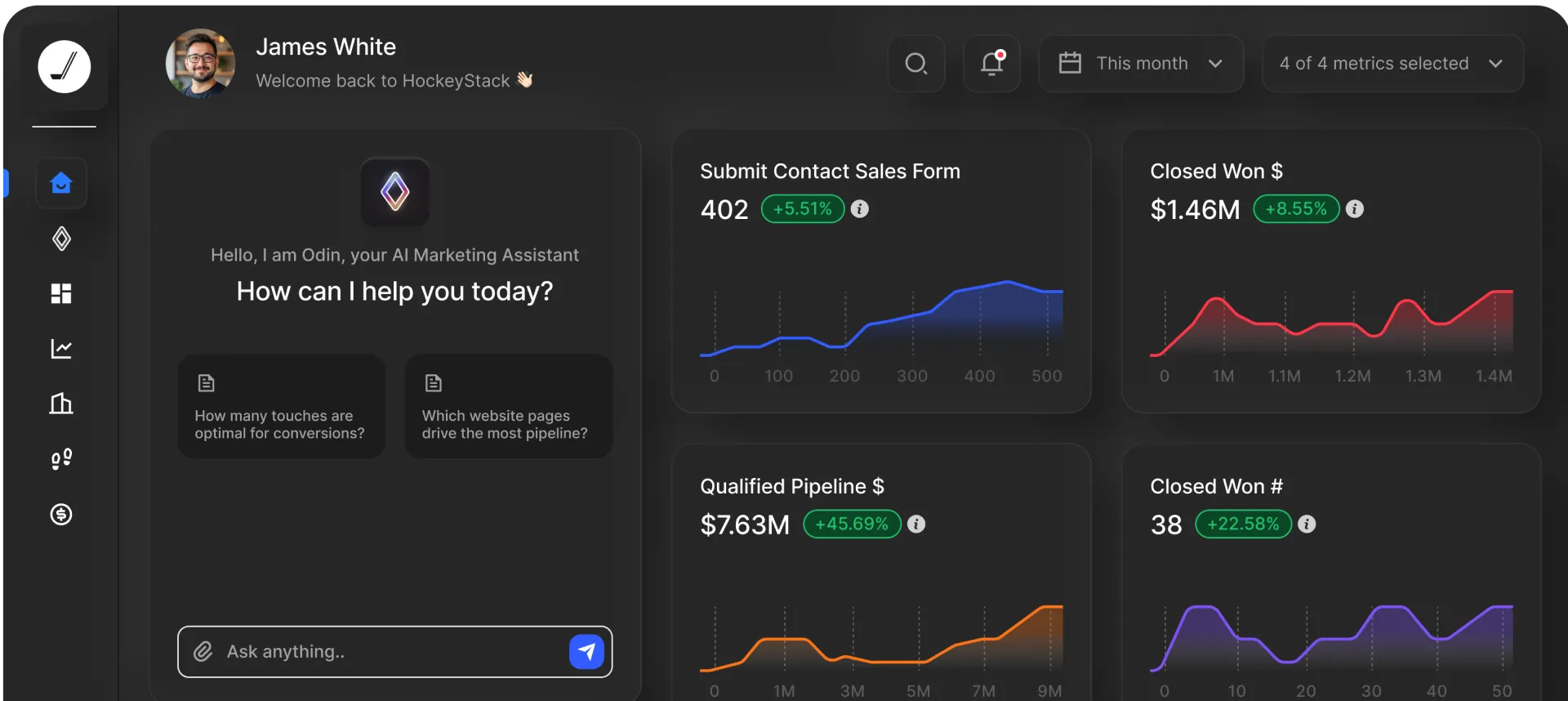B2B Marketing Attribution: The 2025 Playbook

B2B Marketing Attribution: The 2025 Playbook
.avif)
Throwing darts in the dark and hoping they hit the target—that's what B2B marketing feels like without proper attribution.
With extended sales cycles, multiple decision-makers, and a web of touchpoints, setting up a reliable attribution model often feels overwhelming.
But ignore it, and you're burning through the marketing budget and missing opportunities.
This article cuts through the confusion. Learn how to implement B2B attribution effectively so you can pinpoint what works, eliminate what doesn't, and make data-driven decisions that actually improve your bottom line.
What Is B2B Marketing Attribution?
B2B marketing attribution refers to tracking and analyzing which marketing actions lead to conversions and sales in a business-to-business setting.
It's about dissecting the buyer's journey—every email opened, webinar attended, or whitepaper downloaded—and assigning credit to each interaction to see what campaigns and touchpoints are moving the needle.
Accurate attribution helps you:
- Optimize budget allocation: When you find high-performing channels, you can direct more of the budget to them and reduce spending on low-impact activities.
- Refine campaign targeting: Attribution reveals which messaging hits a chord with your audience so you can personalize future campaigns to match those key segment preferences.
- Enhance lead nurturing efforts: Knowing which touchpoints move leads further down the funnel lets you strategically sequence content and interactions.
- Improve cross-channel coordination: B2B attribution clarifies the role each channel plays in the buyer's journey so you can create better synergy across marketing activities from one touchpoint to the next.
Key Touchpoints in the B2B Customer Journey
A "touchpoint" in B2B marketing refers to any interaction a potential customer has with your brand throughout their journey to becoming a client.
The following stages represent the most important touchpoints in a customer journey for attributing credit to marketing efforts:
First Engagement (Top of the Funnel)
The first touchpoint is where potential customers become aware of your brand and start interacting with your content. This could happen through a blog post they read, a social media post they see, an online ad they click on, or a search result that leads them to your website.
At this top-of-the-funnel stage, prospects are just becoming aware of a problem they need to solve and are looking for more information.
Last Marketing Interaction (Mid-Funnel)
The last touchpoint happens just before a prospect transitions from marketing to sales. This mid-funnel touchpoint can include downloading a detailed whitepaper, attending a webinar, or requesting a product demo.
At this stage, prospects are evaluating their options and are more engaged with your content. Done well, this touchpoint nurtures qualified leads and nudges them closer to a buying decision.
Opportunity Created (Late-Funnel)
The "opportunity created" stage marks a late-funnel milestone where a prospect transitions from being a lead to a qualified sales opportunity.
This touchpoint often involves direct communication, such as a personalized email or a one-on-one meeting. At this point, the prospect is seriously considering your solution.
Opportunity Closed (Bottom of the Funnel)
Opportunity closed refers to the final outcome of the sales process – whether the deal is won or lost.
This bottom-of-the-funnel touchpoint involves final negotiations, contract signing, and onboarding for successful deals.
It's the culmination of all previous interactions and has a direct impact on your revenue.
B2B Marketing Attribution Models
There are two main types of attribution models in B2B marketing:
- Single-touch attribution: Assigns 100% of the credit for a conversion to a single touchpoint, usually the first or last interaction. It’s simple and shows what initially attracted a lead, but it lacks insights into the full journey, so it’s not ideal for complex B2B sales cycles.
- Multi-touch attribution: Distributes credit across multiple touchpoints and gives a more comprehensive view of the buyer’s journey. It covers various interactions—from webinars to emails and demos—and captures the cumulative influence of each stage.
Linear Attribution
This model gives credit evenly across all touchpoints in the customer journey and treats each interaction as equally important. This model provides a full picture of all touchpoints in the customer journey. It highlights each interaction, which makes it useful for longer B2B sales cycles.
However, since it treats all interactions equally, it can overvalue minor touchpoints. It may dilute the impact of crucial stages like first and last interactions, and doesn't offer insights into which stages were most influential.
Time-Decay Attribution
Time-decay attribution gives more credit to interactions that happen closer to the conversion point, gradually decreasing the value of earlier touchpoints. This model highlights recent touchpoints that directly influenced conversion decisions, and it’s very useful for tracking the effectiveness of touchpoints that lead up to a sale.
However, due to the nature of the model, early interactions get less credit, even if they sparked interest. This makes is overall less useful for understanding the full journey or top-of-funnel impact.
U-Shaped (Position-Based) Attribution
The U-shaped (aka position-based) model assigns most of the credit to the first and last marketing touchpoints, with the remainder spread across middle interactions. It demonstrates how important both initial awareness and final conversion stages are, and it’s useful to find which channels are best at attracting and closing leads.
On the flip side, it undervalues mid-funnel interactions that nurture leads along the journey, which makes it less suitable for journeys with highly varied, multiple mid-funnel touchpoints.
W-Shaped Attribution
The W-shaped model assigns significant credit to three critical touchpoints – first touch, lead creation, and opportunity creation, while the rest is distributed among other interactions. It highlights the importance of lead creation in the conversion process, and it’s great for providing insights into which touchpoints move leads from awareness to conversion.
However, it can miss the broader impact of touchpoints that drive ongoing engagement, and may overlook brand-building efforts that influence the buyer's general perception.
B2B Marketing Attribution Challenges
Here are some of the key challenges in marketing attribution that B2B organizations face nowadays:
Resource and Expertise Constraints
Tracking and analyzing B2B attribution data requires specialized skills like data analysis, integration, and technical reporting—skills many teams simply don’t have in-house.
Without them, teams are stuck with manual attribution, which quickly becomes time-consuming and often inconsistent.
Plus, an effective attribution system isn’t a one-and-done setup – it’s an ongoing process that demands time and resources for data collection, regular analysis, and optimization.
It also demands cross-department collaboration where sales, IT, and data science need to work together to keep data flowing seamlessly across systems.
All of this can easily overwhelm teams.
PRO TIP: HockeyStack’s platform takes the technical burden off B2B marketing teams by simplifying multi-touch attribution. Designed for teams with limited technical resources, it offers user-friendly data integration tools and intuitive reports that deliver actionable insights without the heavy lifting. HockeyStack turns complex data into clear, accessible insights, so teams can stay efficient and accurate without needing a data science background.

Data Integration and Silos
In many organizations, marketing data is scattered across multiple platforms—CRM systems, marketing automation tools, web analytics, and more.
Each platform houses its own siloed data, which makes it difficult to create a single view of the customer journey. Without proper data integration solutions, marketing teams can’t see how different touchpoints connect or how marketing campaigns influence the funnel.
Data ownership further complicates things. Different departments or external partners often manage specific data sets—like an agency handling ad data, the internal team managing emails, and social media performance tracked from a separate tool.
PRO TIP: HockeyStack seamlessly integrates with multiple platforms, so you can pull in data from various sources into a single, unified dashboard. This centralized approach gives you a clearer, more complete view of the customer journey—no need for manual data reconciliation.
Complex Customer Journeys
B2B customer journeys are long and complicated, spanning several weeks, months, or even years. Multiple stakeholders are involved, each with their own set of interactions and touchpoints.
Tracking and attributing influence across this extended timeline is difficult (to say the least) and you need to monitor a variety of touchpoints that contribute to the decision-making process.
Another issue is that a single purchase decision can involve multiple roles—executives, end-users, and procurement teams—each interacting with different content and channels.
Capturing this nuanced information is essential for accurate attribution but is also incredibly challenging to execute, especially as the buying committee grows.
PRO TIP: HockeyStack excels in tracking complex B2B buyer journeys by allowing you to segment and analyze data based on stakeholder roles and specific touchpoints over time. You can distinguish between different user profiles within the same account and better understand each influencer's specific journey.
Multiple Touchpoints Contributing to the Final Sale
B2B marketing strategies typically involve a mix of online and offline channels—webinars, whitepapers, social media, trade shows, and direct sales calls, to name a few.
With so many touchpoints contributing to the final sale, figuring out the most impactful ones demands sophisticated attribution models and a well-coordinated approach.
Offline interactions make attribution even trickier. In-person meetings or phone calls are harder to track and quantify than digital engagements, and they often rely on manual data entry that’s prone to human error or bias.
PRO TIP: HockeyStack provides robust multi-touch attribution capabilities, so you can capture and analyze data across both digital and offline touchpoints. You can centralize these interactions in one platform and reduce manual tracking errors.

Lack of Cookie-Based Tracking
Traditional tracking methods—like cookies—are generally less effective in B2B contexts.
It’s because prospects tend to use multiple devices and share IP addresses within corporate networks, making it difficult to accurately track individual behaviors.
Privacy regulations and browser restrictions also limit cookies’ effectiveness. Without precise tracking, it's tough to understand how prospects move through the funnel and which touchpoints have the biggest impact.
PRO TIP: HockeyStack offers cookieless tracking solutions that overcome these challenges. With advanced tracking methods that don't rely on cookies, HockeyStack provides a more accurate and privacy-compliant way to monitor user behavior across devices and touchpoints.
Changing Buyer Behaviors
Modern B2B buyers interact with brands through a variety of channels, from social media and email to webinars and in-person events.
This multichannel engagement fragments the buyer's journey, and it makes it even harder to pinpoint which interactions truly drive decision-making.
On top of that, new digital marketing tools and platforms keep popping up, which pushes marketers to constantly adjust their attribution strategies. Each platform shift or update means recalibrating models to keep attribution accurate, piling on demands for marketing teams.
How to Get Started with B2B Marketing Attribution
To create a B2B marketing attribution model, you need a step-by-step approach that clarifies each stage of the buyer's journey, captures relevant data, and ties actions directly to revenue impact.
1. Define Clear Objectives
A working B2B marketing attribution model starts with crystal-clear objectives.
Once you’ve set your objectives, select KPIs that reflect these goals.
Each KPI you choose should directly support your broader objectives and offer a specific lens through which you can analyze performance.
With your goals and KPIs in place, it’s time to choose an attribution model that aligns with the nature of your B2B customer journey.
When sales cycles are longer and involve numerous stakeholders, it’s better to use multi-touch attribution models that account for the influence of multiple interactions.
For shorter, more direct journeys, single-touch models like first-touch or last-touch may be a better alternative.
2. Map the Customer Journey
A B2B journey might include stages like:
- Initial website visit or social media engagement
- Content download or blog post read
- Requesting a demo or signing up for a webinar
- Recommendations from existing customers or partners.
- Attendance at trade shows, conferences, or workshops.
- Conversations with sales representatives, whether by phone or in person.
- Final purchase or contract signing
Having this path sketched out lets you see where key interactions happen, and it gives structure to your attribution model.
Not every touchpoint carries equal weight in influencing conversions. Interactions like demo requests or case study downloads have a stronger impact than website visits.
That’s why you need to assign weights or scores to these touchpoints based on their perceived influence.
Step 3: Audit Your Marketing Efforts
An audit isn’t limited to digital platforms like your website, content marketing efforts, email campaigns, and paid advertising – it should also cover offline efforts such as events, webinars, and any direct outreach by your sales team.
For a thorough analysis, examine:
- Key website interactions such as landing page views, blog reads, contact form submissions, and product page visits.
- Content marketing touchpoints such as downloads of resources like ebooks, whitepapers, or case studies, as well as video views and engagement with blog posts.
- Social media touchpoints like ad clicks, post engagements, shares, and comments.
- Email campaign opens, clicks, replies, and any conversion actions prompted by emails, such as event sign-ups or demo requests.
- Paid ads interactions with display ads, paid search, retargeting efforts, and video ads across platforms.
- Events and webinar registrations, attendance, and follow-up actions taken after these engagements.
Categorize each touchpoint by its primary function, then ensure you have the necessary tools and tracking systems in place for each channel.
Offline activities, such as events or phone calls, may require additional manual tracking methods that you need to include in your data.
4. Collect and Integrate the Right Data
Start by collecting data from each system that captures customer interactions:
- Website analytics: Use tools like Google Analytics 4 to monitor website visits, landing page interactions, bounce rates, and other on-site behaviors.
- CRM: Track customer profiles, touchpoint history, sales interactions, and customer journey stages within your CRM.
- Marketing automation: Gather engagement data from email campaigns, content downloads, and lead nurturing workflows.
- Advertising platforms: Pull in data from Google Ads, social media ads, retargeting platforms, and any other paid media sources to understand campaign performance.
- Offline data sources: Include interactions from events, phone calls, or in-person meetings, which may require manual data entry or specialized tracking tools.
To accurately capture touchpoints across channels, you need to set up tracking mechanisms.
For example, you can use UTM parameters to track digital campaign sources, mediums, and specific content.
Finally, all data sources should be brought into a centralized repository, like a data warehouse or a marketing analytics platform.
This integration creates a “single source of truth,” where you can analyze the entire customer journey without switching between platforms.
5. Implement Your Model and Track Results
Select tools with robust attribution capabilities—either standalone attribution software (e.g., HockeyStack) or features within your CRM and analytics platforms (e.g., HubSpot, Google Analytics 4).
These attribution tools offer granular settings that help you customize the model to your needs, such as adjusting weights, setting lookback windows, or defining multi-touch rules.
Then, set up dashboards that allow you to monitor attribution across multiple dimensions—such as time, customer segments, or specific funnel stages.
For example:
- Time-based analysis: Track changes over time to see if certain touchpoints gain or lose influence in specific quarters.
- Segmented views: Break down attribution by customer segment (e.g., B2B company size, industry) to understand which touchpoints matter most to each group.
- Stage-specific marketing performance: Monitor how touchpoints contribute at each funnel stage. For instance, webinars may be effective at the awareness stage, while case studies might be more influential in decision-making.
Visualizing these insights with real-time dashboards helps you adjust strategies based on live customer data, especially if certain touchpoints perform unexpectedly well or show a drop-off.
How HockeyStack Can Help
From multi-touch attribution features to real-time custom dashboards, HockeyStack is designed to help you extract actionable insights across every stage of the customer journey.
Let’s check out exactly how HockeyStack can help:
Connect All Your Data Sources
HockeyStack has integrations with a wide range of platforms, including your website, CRM systems, marketing automation tools, advertising platforms, and more.
You can consolidate all your data into a centralized hub and let HockeyStack eliminate the chaos of data silos with a holistic view of your customer journey.
Track Every Customer Touchpoint with Precision
HockeyStack captures detailed event data across all your marketing channels with its website analytics, including website visits, ad clicks, email opens, content downloads, form submissions, and even product usage.

This comprehensive tracking lets you monitor each step of the journey, from initial awareness to final conversion and more.
Customizable Attribution Models for Tailored Insights
With HockeyStack, you’re not limited to pre-set models. You can customize attribution models to match your unique business goals and customer behavior patterns.
Whether you need to weigh specific touchpoints differently or apply time-decay logic, HockeyStack’s advanced customization options let you build a model that aligns with your exact needs.
Revenue Attribution to Tie Marketing Efforts Directly to Sales
HockeyStack doesn’t just attribute conversions - it allows you to tie every touchpoint back to revenue.
With revenue attribution, you can pinpoint which specific campaigns, channels, or content pieces directly influence your bottom line.
Learn how Bloomreach uses HockeyStack to attribute revenue and prove marketing’s impact.
Insightful Dashboards for Quick, In-Depth Analysis
HockeyStack’s customizable dashboards provide a real-time view of your key performance metrics, so you can quickly analyze trends, measure campaign performance, and track user behavior at a glance.
These dashboards are designed to be intuitive and accessible, giving your team a visual, data-rich interface to uncover insights without getting lost in complex data.

These dashboards are designed to be intuitive and accessible, giving your team a visual, data-rich interface to uncover insights without getting lost in complex data.
B2B Attribution Made Easy with HockeyStack
HockeyStack takes the complexity out of B2B marketing attribution, giving you a streamlined, all-in-one platform to track, analyze, and act on every stage of your customer journey.

No more piecing together data from multiple tools—HockeyStack centralizes everything, so you have a full, real-time view of your marketing impact and revenue drivers.
With HockeyStack, you can:
- Gain actionable insights by tracking every customer interaction across channels, from initial awareness to conversion, making sure nothing goes unnoticed.
- Identify high-value accounts and prioritize outreach based on advanced account-level and intent data, so you can focus on the opportunities most likely to convert.
- Connect marketing to revenue with precision, leveraging multi-touch attribution models that reveal exactly where your efforts are paying off.
- Make data-driven decisions with intuitive, customizable dashboards and automated reporting to remove guesswork and allow your team to act confidently.
If you’re ready to see how easy and powerful attribution can be, book a demo today with HockeyStack.
Content Repurposing
In this episode, Obaid breaks down how repurposing your substance is a more effective way to repurpose your content than repurposing an end-asset.


Ready to see HockeyStack in action?
HockeyStack turns all of your online and offline GTM data into visual buyer journeys and dashboards, AI-powered recommendations, and the industry’s best-performing account and lead scoring.

Ready to See HockeyStack in Action?
HockeyStack turns all of your online and offline GTM data into visual buyer journeys and dashboards, AI-powered recommendations, and the industry’s best-performing account and lead scoring.




